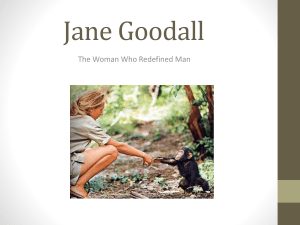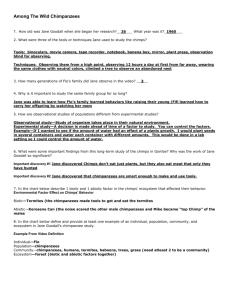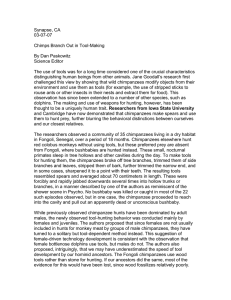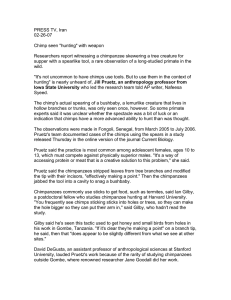Caryn Asherson SED 625SC Dr. Rivas
advertisement
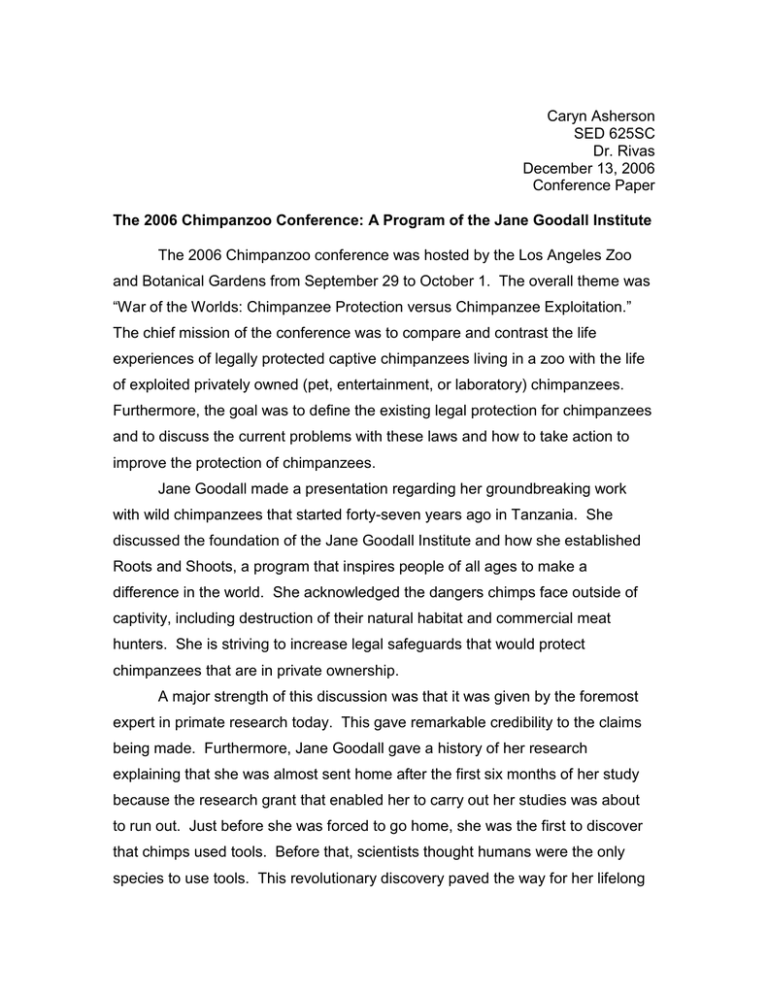
Caryn Asherson SED 625SC Dr. Rivas December 13, 2006 Conference Paper The 2006 Chimpanzoo Conference: A Program of the Jane Goodall Institute The 2006 Chimpanzoo conference was hosted by the Los Angeles Zoo and Botanical Gardens from September 29 to October 1. The overall theme was “War of the Worlds: Chimpanzee Protection versus Chimpanzee Exploitation.” The chief mission of the conference was to compare and contrast the life experiences of legally protected captive chimpanzees living in a zoo with the life of exploited privately owned (pet, entertainment, or laboratory) chimpanzees. Furthermore, the goal was to define the existing legal protection for chimpanzees and to discuss the current problems with these laws and how to take action to improve the protection of chimpanzees. Jane Goodall made a presentation regarding her groundbreaking work with wild chimpanzees that started forty-seven years ago in Tanzania. She discussed the foundation of the Jane Goodall Institute and how she established Roots and Shoots, a program that inspires people of all ages to make a difference in the world. She acknowledged the dangers chimps face outside of captivity, including destruction of their natural habitat and commercial meat hunters. She is striving to increase legal safeguards that would protect chimpanzees that are in private ownership. A major strength of this discussion was that it was given by the foremost expert in primate research today. This gave remarkable credibility to the claims being made. Furthermore, Jane Goodall gave a history of her research explaining that she was almost sent home after the first six months of her study because the research grant that enabled her to carry out her studies was about to run out. Just before she was forced to go home, she was the first to discover that chimps used tools. Before that, scientists thought humans were the only species to use tools. This revolutionary discovery paved the way for her lifelong research. By relating this personal story to her audience, she seemed to be forming a relationship with her listeners. She spoke in a relaxed, non-technical way as if she was having a conversation with a friend over lunch. This informal approach inspired listeners to take up her cause. Since Jane Goodall is a renowned primatologist and one of the major pioneers of primate research, it is not surprising that I had difficulty finding any weaknesses in her presentation. She made an excellent argument against the use of chimpanzees for research in medical laboratories. However, one suggestion that I have for future conferences would be to include speakers who represent the side of the medical laboratories, as well as those opposed to the use of chimpanzees in labs. By allowing a representative from the health industry to share the purposes and benefits of using the chimpanzees for research, any cause for bias would be removed. As a teacher, I am always trying to demonstrate to my students that they can make a difference. They can choose the impact that their actions will have on the world. This lecture inspired me to teach my students that they can make small changes that will add up and lead to big changes. I am equipped with knowledge on how to encourage my students to become conservationists. I received information on beginning a Roots and Shoots chapter in my school. The goals of the program include making the world a better place for people, animals, and the environment. It encourages students to give back to their community. I teach about ecology and endangered species and getting my students interested in the plight of the chimpanzees can ultimately lead to discussions about the environment and the ability of the students to protect it. This lecture left me feeling well prepared to urge my students to recognize their personal responsibility to effect change through their actions.

